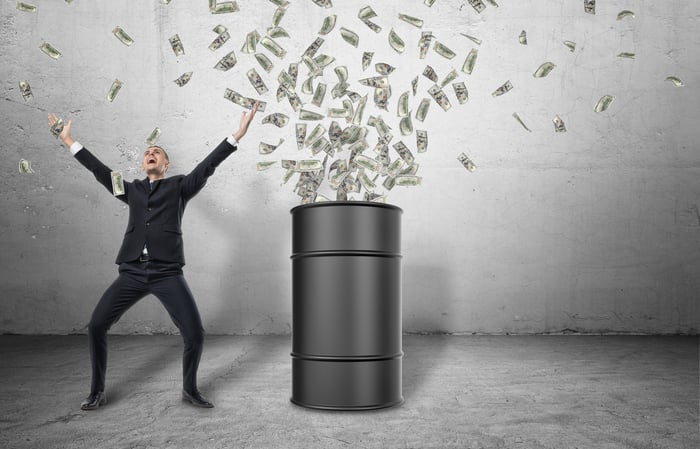EOG Resources (EOG -0.42%) recently put the wraps on 2017, reporting results that exceeded its initial expectations. The company also unveiled its outlook for 2018, anticipating another 16% to 20% increase in oil production. That said, one noteworthy aspect of the company's budget for this year is that it doesn't plan on reinvesting all its anticipated cash flow into drilling more wells. Instead, its current strategy would generate a whopping $1.5 billion in free cash flow if oil averages $60 a barrel this year. That leaves it with an interesting problem, which CEO Bill Thomas addressed on the fourth-quarter call.
The answer to the burning question
Given the company's outlook that it would generate significant excess cash if oil remains above $60 a barrel this year, an analyst on the call wanted to know what it plans to do with that money. While the analyst noted that EOG already boosted its dividend 10% this year and said it would pay off an upcoming $350 million debt maturity, the questioner also pointed out that "clearly, there are going to be proceeds beyond that." That led to the following inquiry, which was likely already on everyone's mind: "What else is EOG potentially planning to do with the money?"
The CEO took that one, outlining the company's priorities for its cash flow, which he said "haven't changed." Thomas continued:
Our first priority is to use free cash flow and reinvest it into high return drilling. We think this is the best way to continue to improve the company, to increase ROCE [return on capital employed], and the shareholder value. The one caveat on that is, we're not going to ramp up spending at the cost of returns.

A gusher of cash flow hasn't changed EOG's plans. Image source: Getty Images.
In other words, in an ideal world, EOG would plow that money back into more wells because that's what would typically create the most value for investors. However, he noted that the company would hold back if the incremental spending would affect returns. That's the case this year, since service and equipment costs are rising sharply. As a result, the company wants to work on mitigating the impact of this inflation before increasing spending further. That seemingly leaves an opening for the company to expand its budget later this year.
Next, Thomas noted:
We want to continue to firm up our balance sheet. Our goal is to have an impeccable balance sheet, and we're going to pay off the bond this year. As we go forward, we want to incrementally continue to reduce debt and firm up the balance sheet. This gives us so much flexibility. It served us so well during the last downturn. We didn't have to issue equity or cut the dividend. We want to be a consistent deliverer of shareholder value throughout the commodity cycles.
He then pointed out that having a strong balance sheet "does position us to take advantage of opportunities for maybe an acquisition" and added, "We continue to look at those." That's noteworthy, since EOG has traditionally avoided making acquisitions. While it did buy Yates in 2016, the company's primary focus has been on organic exploration, which has enabled the company to create more value because it has avoided paying the higher price of acquisitions, which has saddled peers with debt in recent years. However, by letting cash pile up on its balance sheet, EOG could pounce if the right opportunity presented itself.
He concluded by saying that "our third priority is our commitment to the dividend," noting that the company has now increased it 17 times in the past 19 years. As such, if cash flow continues to grow, the company could raise the dividend again this year.

Image source: Getty Images.
The one thing he didn't mention
What was strangely absent from the capital allocation priorities Thomas discussed was any hint of using free cash flow to repurchase shares, which is something a growing number of peers plan to do this year. For example, Devon Energy (DVN -0.98%) recently unveiled a $1 billion buyback plan, while Hess (HES 0.36%) added $1 billion to its repurchase authorization, boosting it to $1.5 billion. One reason is that EOG's stock has held up well during the downturn, rising 17% over the past three years while shares of Hess and Devon are down 30% and 43%, respectively, over that time frame. Therefore, EOG doesn't need to buy back shares to boost a sagging stock price.
No need to rush
EOG Resources made it clear that it has no intention of changing its capital allocation priorities just because it expects to generate more cash than it needs this year. While peers like Devon and Hess are using their windfall to buy back their beaten-down shares, EOG doesn't need to follow in their footsteps. Instead, the company has no problem letting that cash pile up on its balance sheet until a compelling opportunity arises to grow shareholder value either through accelerating its high-return drilling program or pouncing on an unbelievable deal. It's one of the many things that sets EOG apart from its rivals.


